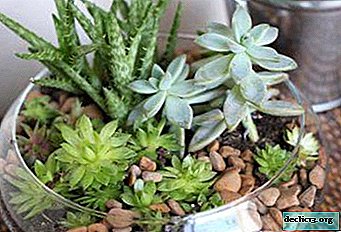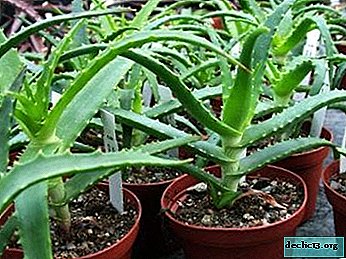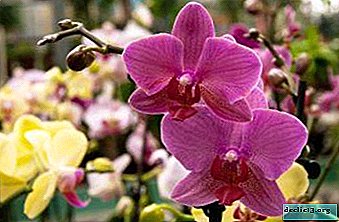All types of cactus without thorns: names, photos, description of plants

It is hard to argue that home plants are a wonderful decorative element in any interior.
They fill the house with freshness, create an atmosphere of comfort and simply delight the eye. The most original of our green friends are, of course, cacti.
And although these plants are very unpretentious in care, to many they seem aggressive because of the presence of thorns.
But cacti are very diverse. Consider several species that are distinguished by beauty and sophistication, and at the same time lacking.
Cactus family without needles: all types, names and photos
Next, all varieties of interesting cacti without needles with names and photos will be presented.
Hatiora (lat.Hatiora)

Despite the fact that the hator belongs to the cactus family, in appearance it is quite difficult to call it a cactus in the usual sense. It has no leaves, no thorns and consists of many small segmented, branching stems. Most of the hator resembles a coral bush. The British call this plant Dancing bones cactus (cactus of dancing bones).
Originally from Brazil, the hatiora blooms in winter or early spring. Small bright yellow flowers similar to bells appear at the ends of the upper segments.
This plant does not like too much heat. The ideal temperature in summer will be + 20 ... + 22 ° C, in this case the hator can be taken out into the open air, in the garden or on the balcony. It should be watered every 3-5 days, in the winter, not more than 1 time in 10-12 days. The land between the irrigations must be dry. It is undesirable to keep it in the draft.
Hatoria stems are quite fragile, so you need to handle it very carefully.We offer you to watch a video about Hachior's cactus:
Ripsalis (lat.Rhipsalis)

The homeland of ripsalis is South America, but it is also found in India.. This plant also has a very unusual appearance for cacti. The stems of bright green color have a ribbed or rounded shape, often branch and hang very beautifully. Therefore, it looks especially impressive in a suspended basket. Ripsalis blooms profusely in winter at home. The shades of flowers are varied, from white and yellow to pinkish-red.
This plant does not require special attention in the care. Enough moderate lighting and temperatures not lower than + 10 ° C in the winter and + 18 ... + 24 ° C in the summer. The main feature of ripsalis is its aerial roots, with the help of which it absorbs moisture. Therefore, it should be periodically sprayed with warm water. You need to water abundantly from March to September, maintaining moisture in the ground. The rest of the time you can moisten occasionally.
In the period April-August, it is recommended to feed with fertilizers, mainly in liquid form.
It is undesirable to often move ripsalis. He prefers a constant regimen, any violation of which can lead to stress.We offer you to watch a video about the Ripsalis cactus:
Epiphyllum (lat.Epiphyllum)

This plant is also called forest cactus. Epiphyllum originates from the tropics and subtropics of America. Its main distinguishing feature is the complete absence of leaves and thorns. Instead, Epiphyllum has leaf-shaped stems of dark green hues, flat or triangular in shape. This non-prickly plant enjoys special popularity among flower growers due to very beautiful flowers reaching a diameter of up to 12 cm.
The color of the flowers of Epiphyllum is diverse:
- Violet
- orange
- bright red;
- white
- as well as mixed in various versions.
Epiphyllum does not like direct sunlightIt is preferable to keep it in a room with ambient light. At the same time, under very low light the plant may not bloom. In spring and summer, the desired temperature for it is + 20 ... + 25 ° C, in winter + 12 ... + 15 ° C. Humidity is not particularly significant.
Watering, like most cacti, should be done as the soil dries.We offer you to watch a video about the Epifillum cactus:
Pereskia (lat.Pereskia)

This is one of the oldest cacti, it is distributed in warm, dry areas from northern Mexico to the South American tropics. Outwardly, it is a large bush (or even a short tree) with green or purple leaves. The leaves are fleshy and smooth, but, unlike other cacti without thorns, they are present on the stems of this plant.
Pereskia loves bright lighting and moderate humidity. It should not be kept in the shade, otherwise the plant will become ill. The ideal temperature for it is + 22 ... + 25 ° C. In the warm period, watering depends on the drying time of the soil, in winter, the cross must rarely be watered, otherwise the leaves may crumble.
You can periodically spray the leaves, then they will look healthier. In the spring, it is advisable to feed the plant twice a month. In winter, feeding is not necessary.We offer you to watch a video about Pereskia cactus:
Lophophora (lat. Lophophora)

Special attention is given to the lophophore cactus (it is also called peyotl). The homeland of which is considered the mountain slopes of Mexico and the United States. This plant has a spherical stem shape with a velvety surface. Visually lophophora as it were consists of several fused and swollen convex segments. It blooms in summer, small (about 2 cm) tubular flowers have many petals from white to a reddish hue (read about cacti with red flowers here).
Lofofora prefers bright but diffused light. It is unpretentious to temperature and can withstand up to + 40 ° C in summer. In winter, it is better to keep it at a temperature no higher than + 10 ° C, but at the same time maintain good lighting. Lofophore does not need additional hydration, and it is worth watering it 1-2 days after the final drying of the soil. It should be fed 1 time per month during the period when intensive plant growth is observed.
The juice of the plant has an unusual composition with the presence of alkaloids. Some species, such as lophophore Williams, are forbidden to grow in the Russian Federation in more than two copies.Cacti are the most extravagant representatives of the home flora. Their unusual appearance and special beauty during the flowering period, of course, will bring fresh notes to the interior of any room. If you are worried about the safety of small children or pets, a cactus without thorns would be an ideal option.

















